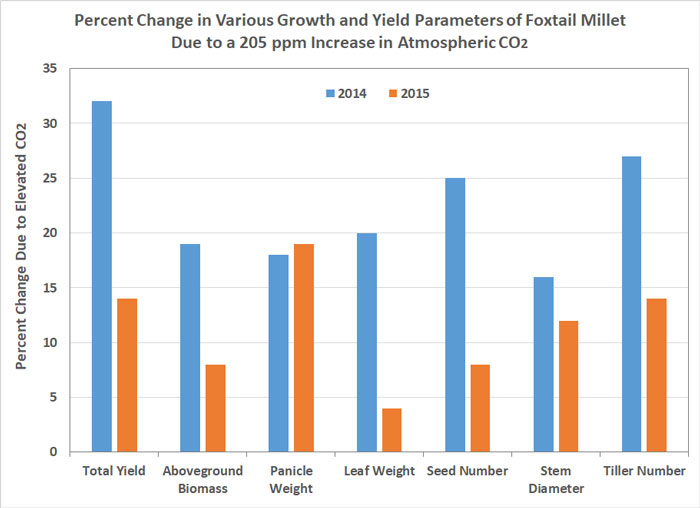| Tweet | Follow @co2science |
Paper Reviewed
Li, P., Li, B., Seneweera, S., Zong, Y., Li, F.Y., Han, Y. and Hao, X. 2019. Photosynthesis and yield response to elevated CO2, C4 plant foxtail millet behaves similarly to C3 species. Plant Science 285: 239-247.
It is often claimed that C4 crops will remain relatively unresponsive to future atmospheric CO2 enrichment, as they possess a CO2 concentrating mechanism that allows them to achieve a greater photosynthetic capacity than C3 plants at the current atmospheric CO2 concentration, particularly at high growth temperatures. However, this view is far from correct, evidenced by the many studies revealing significant CO2-induced growth enhancements in C4 plants highlighted in our Subject Index (see the subheadings under C4 Plants) and throughout our Plant Growth Database. The most recent study to prove as much comes from the Asian research team of Li et al. (2019).
Working with foxtail millet (Setaria italica), a nutrient-rich crop traditionally grown in arid and semi-arid regions due to its high drought tolerance level, the seven scientists examined the photosynthetic and yield response of this important C4 species to a 205 ppm CO2 enrichment. The plants were grown in pots in open-top chambers at Shanxi Agricultural University in Taigu, Shanxi, China, in two separate growing seasons (2104 and 2015) under either ambient (385 ppm) or elevated (590 ppm) CO2 conditions. Fertilizer was added to the soil and irrigation was added to supplement rainfall and ensure no water stress Photosynthetic measurements were made at multiple times during the growing season and at the end of each season the plants were harvested and growth characteristics measured.
With respect to photosynthesis, the authors repot that net photosynthesis increased due to elevated CO2 at all stages of plant development. More specifically, it increasing by 21%, 73% and 123% at the heading, anthesis and grain-filling stages in 2014 and by 7% and 19% at anthesis and grain-filling in 2015 (note that measurements were not made at the heading stage in 2015). Such improvements were largely responsible for the similarly-observed increases in plant water use efficiency at the heading (+77%), anthesis (+8%) and grain-filling (+41%) stages in 2014 and at anthesis (+45%) and grain-filling (+56%) in 2015. With respect to biomass and yield-related parameters, as shown in Figure 1, elevated CO2 increased the tiller number, stem diameter, seed number, leaf weight, panicle weight, aboveground biomass and total yield by 27%, 16%, 25%, 20%, 18%, 19% and 32% in 2015, respectively, and by 14%, 12%, 8%, 4%, 19%, 8% and 14% in 2015, also respectively.
Li et al. also performed transcriptomic analyses to identify differentially expressed genes under the ambient and elevated CO2 treatments that might explain the above observations. In all, 66 differentially expressed genes were noted. Such up or down regulation of the genes were identified for their role[s] in "cell wall reinforcement, shoot initiation, stomatal conductance, plant hormone signal transduction, carbon fixation, glycolysis/gluconeogenesis being responsive to elevated CO2." And they add that "changes in these genes reduced plant height, increased stem diameters, and promote CO2 fixation," all of which findings, they say, "suggest that under increasing CO2 concentration in the future, foxtail millet, a C4 species will not forfeit its advantage to C3 crops."
It would thus appear that, despite being a C4 plant, foxtail millet is fully capable of benefiting from the ongoing rise in atmospheric CO2, and it will do so in the same relative degree to that observed in C3 plants.

Figure 1. Percent change in total yield, aboveground biomass, panicle weight, leaf weight, seed number, stem diameter and tiller number of Foxtail Millet plants due to a 205 ppm increase in atmospheric CO2. Plants were grown in the field in open-top chambers in both 2014 and 2015.




